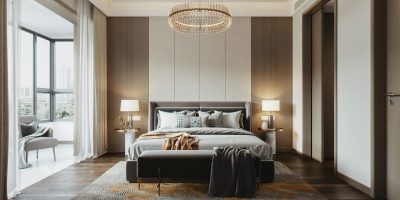Interior Design: A Unique Approach to Creating Inspiring Spaces.
Interior design is an art form that brings together functionality, aesthetics, and emotional resonance to create spaces that enhance our daily lives. It is about more than just choosing the right furniture or paint colors; it is about understanding the rhythm of a space and how it can be molded to serve the needs and desires of those who inhabit it. When it comes to interior design, the possibilities are endless, and each space offers the opportunity to craft something truly unique.

The Power of Personalization.
One of the most important aspects of interior design is personalization. A well-designed home or office should reflect the personality, lifestyle, and values of the people who use it. The best interiors are those that make the user feel truly at home, where every detail—from the color palette to the arrangement of furniture—speaks to their individuality.
Personalization begins with understanding the way a space will be used. For example, an open-concept living area may require a different approach than a traditional, compartmentalized home. Designers must consider how each space will function: a family room may need to accommodate large gatherings, while a home office requires an environment conducive to focus and productivity. The design should take into account these needs, while also weaving in the unique tastes of the inhabitants.
The Intersection of Function and Form.

A unique interior design seamlessly blends function and form. Often, design is about striking the perfect balance between creating an aesthetically pleasing space and ensuring that it meets practical needs. For instance, an open-plan living area might look spectacular with a minimalist design, but if the layout fails to consider how people move through the space, it can quickly feel disjointed.
Functionality is an underlying principle that should always guide design decisions. The materials chosen for a space need to support its intended use. A durable, stain-resistant fabric on a sofa is crucial for a family with young children, while a sleek, contemporary dining table might be the perfect centerpiece for a minimalist kitchen. Thoughtful design incorporates these practical considerations without sacrificing style.
Embracing Sustainability.
In recent years, there has been a shift toward sustainability in interior design. As more people recognize the importance of reducing their carbon footprint, eco-friendly design practices have gained traction. Sustainable interiors focus on the careful selection of materials, products, and design choices that minimize environmental impact.
This includes sourcing furniture and materials that are responsibly harvested, using recycled or upcycled items, and choosing paints and finishes that are low in volatile organic compounds (VOCs). Even the use of energy-efficient lighting and appliances can make a significant difference. These sustainable choices not only reduce waste but also create healthier living environments.
Layering Textures, Colors, and Patterns.

One of the most fun aspects of interior design is playing with textures, colors, and patterns. These elements can dramatically transform a space, turning it from bland to breathtaking. A combination of different textures—such as plush velvet cushions, sleek leather chairs, and rustic wooden tables—adds depth and dimension to a room.
Color, too, plays a vital role in setting the mood of a space. A well-considered color palette can make a room feel calming, energizing, or sophisticated. Neutral tones like beige, white, and gray are versatile and timeless, but they can sometimes feel sterile. To bring life to a neutral space, designers often add pops of color through accessories, artwork, or accent walls. Conversely, bold, vibrant hues can energize a space, but too many contrasting colors can overwhelm the eye.
Lighting: The Ultimate Design Tool.
Lighting is perhaps one of the most overlooked elements in interior design, but it has the power to change the entire mood and function of a space. The right lighting can make a room feel cozy and inviting or bright and airy. Layering light sources—ambient, task, and accent lighting—creates depth and allows a space to be adjusted for different moods and functions.
Ambient lighting provides the overall illumination needed for a room. This can be achieved through overhead lights, such as chandeliers, pendant lights, or recessed lighting. Task lighting is more focused and is designed for specific activities, such as reading, cooking, or working. Desk lamps and under-cabinet lighting are perfect examples of task lighting.


